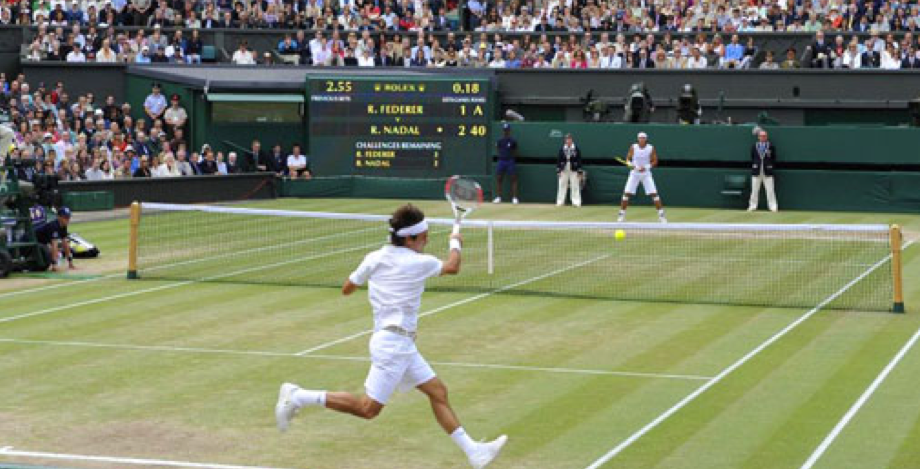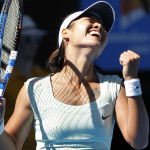
On Saturday, in Melbourne, Australia, the Belgian, Kim Clijsters faced the first ever Chinese player to appear in a singles Grand Slam final, Li Na.
PLEASE CLICK to LISTEN to an ENGLISH TEACHER reading out loud this article on Tennis Vocabulary
Clijsters opened up the first game with an ace and then held the game to love. (Don t worry if you don t understand all this tennis vocabulary. There is a glossary, which explains everything at the bottom of the page!).
In the next game, Clijsters broke Li s serve to love. Li then got the better of her nerves and immediately broke back in the third game. The rest of the points in the first set were furiously competitive as both players hammered home thundering forehands, which took most games to deuce.
Finally, Li took the first set with a fantastic cross-court winner, which must have excited the millions of fans supporting her back home in China. Li couldn t maintain that momentum though, as she served a double fault to gift the opening game of the second set to Clijsters.
This started a run of 5 games going against the serve in the set, which the Belgian eventually won 6-3. In the end, Clijsters showed her class and won the final set to secure her fourth Grand Slam victory, to add to her 3 US Open titles.

Sunday saw the Men s title being contested between two great friends, 5th Seed, Andy Murray and 3rd Seed, Novak Djokovic.
The semi-final had seen defending champion, Roger Federer beaten by Djokovic, so most pundits were backing him to defeat Murray. Djokovic won his opening service game easily to lead 1-0.
Murray had a harder time of it though. He battled through four deuces, missed several opportunities at advantage and saved one break point, before finally winning the game after 15 minutes. That turned out to be the pattern of the first set.
At 4-5 down, Murray had to serve to stay in the set. At 15-30, a monstrous, 38-shot rally was lost by Murray as he hit the net: that left Djokovic with two set points. He only needed one though, as Murray s attempt at a backhand was called out.
He appealed to the umpire for a ruling by Hawk-Eye, but it was in vain. Djokovic led 5-0 in the second set, before Murray clawed back 2 games. However, the high number of unforced errors and low first serve percentage from Murray meant that couldn t survive with Djokovic, who broke again to win the set 6-2.
The third set was littered with more baseline rallies ending with booming forehand winners down the line from both players. But Djokovic was clearly the better man on the day and broke Murray s serve yet again to win the 3rd set 6-3 and pick up his second Australian Open title.
Tennis Vocabulary
- Final
- the last match in a tournament to decide who becomes the champion
- Ace
- a serve, where an opponent does not make contact with the ball
- To hold a game
- to win a game in which you are serving
- Love
- the name for zero in Tennis. If you hold a game to love, it means that you win your own service game without your opponent scoring any points
- To break
- to win a game where you are the receiver, i.e. you are not the server
- Point
- one unit of scoring
- Set
- a group of games. A player normally needs to win 6 games (but can be more) to win a set.
- Forehand
- a shot played with the palm of the hand facing in the direction of the stroke normally more powerful and effective than a backhand
- Game
- A group of points. You need at least 4 points to win a game and a player needs at least 6 games to win a set.
- Deuce
- The name of the point played when the score is at 40-40 in a game, i.e. when both players have won 4 points. After deuce the next score is called Advantage to whichever player won the deuce point. Get it?
- Cross-court winner
- when a player hits the ball from one side of the court (the playing area) to the other and wins a point, i.e. hitting from right to left, or left to right
- Double fault
- when a server hits their first and second serve badly (hits the net or out ) and loses a point without making the opponent do anything at all.
- Against the serve
- When a player wins a game, where they were not the server same a to break
- Title
- the winner of a final, wins the championship and has the title of winner
- Seed
- the stronger players in a tournament are assigned a specific number/position in an ordered list before the tournament. This is to try to ensure that the better players do not play each other in the early matches.
- Semi-final
- the 2 games played before the final, where there are still 4 players left in the tournament
- Pundit
- an expert in a particular subject, who gives their opinion to the public about what is happening. Normally you have a TV presenter and a pundit hosting sports shows (see my other blog here about SKY Sports pundits who got into trouble last week)
- To stay in the set
- a player must win the next game, or they will lose the set to their opponent
- Rally
- an extended series of shots between players to win one point
- To hit the net
- when a player plays the ball into the net (the material supported between two posts to divide the playing area) and therefore loses the point
- Set point
- a point in which a player will win the set if they win the next point
- Backhand
- a stroke played with the back of the hand facing in the direction of the stroke, normally starting with the arm crossing the body usually a weaker and less attacking shot than a forehand
- Umpire
- the official, who watches the game closely to enforce the rules and decide on matters arising from the play
- Hawk-Eye
- computer software that follows the exact flight of the ball using several cameras. A player can ask the umpire twice in a set to use the Hawk-Eye system if they think that a wrong decision has been made about a ball being called out
- Unforced errors
- when a player makes a mistake when they were not considered to be under pressure in a point, i.e. hitting the ball into the net
- First serve
- the first of 2 serves that a player has for each point normally very powerful and much faster than a 2nd serve.
- Baseline
- the line marking each end of the court
- Down the line
- when a player hits the ball onto their opponent s side of the court on the same right or left hand side of the court the opposite to a cross-court shot

